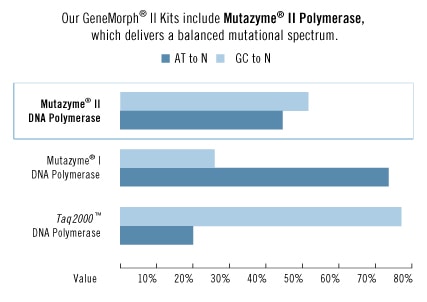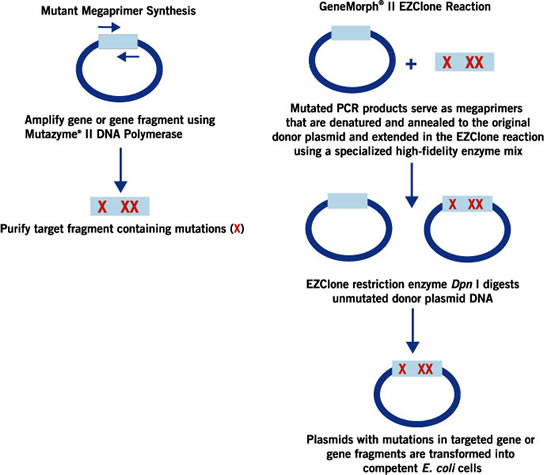GeneMorph II Random Mutagenesis Kits - Details & Specifications
Random mutagenesis is a powerful tool for elucidating protein structure-function relationships and for modifying proteins to improve or alter their characteristics. Error prone PCR is a random mutagenesis technique for generating amino acid substitutions in proteins by introducing mutations into a gene during PCR. Mutations are deliberately introduced through the use of error prone DNA polymerases and/or reaction conditions. The mutated PCR products are then cloned into an expression vector and the resulting mutant library can be screened for changes in protein activity. Random mutagenesis allows researchers to identify beneficial mutations in the absence of structural information, or when such mutations are difficult to predict from protein structure.
The mutational bias exhibited by error prone PCR enzymes undoubtedly skews representation of random mutant libraries, diminishing the effective size of the collection produced by error prone PCR. Mutazyme II DNA polymerase is a novel error prone PCR enzyme blend, formulated to provide useful mutation rates with minimal mutational bias. Mutazyme II is a blend of two error prone DNA polymerases Mutazyme I DNA polymerase (from the original GeneMorph Random Mutagenesis Kit) and a novel Taq DNA polymerase mutant that exhibits increased misinsertion and misextension frequencies compared to wild type Taq. For the Mutazyme II polymerase formulation, the Mutazyme I polymerase and the Taq polymerase mutant have been combined to produce a less biased mutational spectrum with equivalent mutation rates at A’s and T’s vs. G’s and C’s (see Figure 1). Therefore, libraries created with Mutazyme II should exhibit greater mutant representation compared to libraries generated with other enzymes. However, the original GeneMorph I kit favors mutations at G’s and C’s which in some cases may be desirable.
With the GeneMorph II random mutagenesis kit, mutation rates of 1–16 mutations per kb can be achieved using a single set of buffer conditions (MgCl2, balanced dNTPs) optimized for high product yield. The desired mutation rate can be controlled simply by varying the initial amount of target DNA in the reaction or the number of amplification cycles performed.

Figure 1. Mutazyme II polymerase delivers ideal mutational spectrum Mutazyme II DNA polymerase introduces a more uniform mutational spectrum in which mutations at As and Ts occur at the same frequency as Gs and Cs. This approach produces a more comprehensive collection of mutants to discover key functional sites. On the other hand, Taq polymerase under error-prone conditions and the original Mutazyme DNA polymerase deliver bias mutational spectra and many key sites often would go undiscovered.
To address the need for efficient and flexible cloning methods, the GeneMorph II EZClone domain mutagenesis kit offers an easy and fast cloning method to perform targeted random mutagenesis on protein domains and promoter elements, while delivering a uniform mutational spectrum. Utilizing a unique cloning method, the GeneMorph II EZClone kit allows you to target specific protein domains or promoter elements without the need for restriction sites or sub-cloning (see Figure 2). The kit contains Mutazyme II DNA polymerase, which deliberately introduces mutations during PCR with a more uniform mutational spectrum compared to other error-prone PCR enzymes.
Additionally, this kit includes an optimized reaction buffer for the error-prone PCR step so that you need only vary the input DNA amount added to the reaction to produce the desired mutational frequency. The resulting purified mutated PCR products serve as megaprimers for the EZClone reaction during which they are denatured and annealed to the original donor plasmid and extended with a specialized enzyme mix containing a high fidelity DNA polymerase. Using a high-fidelity polymerase minimizes unwanted secondary mutations during the cloning process, which can affect downstream results.
The EZClone reaction is temperature cycled several times before being treated with a unique enzyme to remove parental DNA prior to transformation into competent E. coli. Our XL10-Gold ultracompetent cells are included to maximize library size and diversity. Screening libraries created by random mutagenesis allows researchers to identify beneficial mutations in the absence of structural information, or when such mutations are difficult to predict from protein structure.

Figure 2. GeneMorph II EZClone Mutagenesis Method
For Research Use Only. Not for use in diagnostic procedures